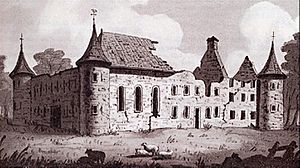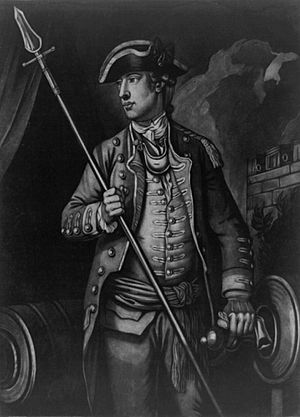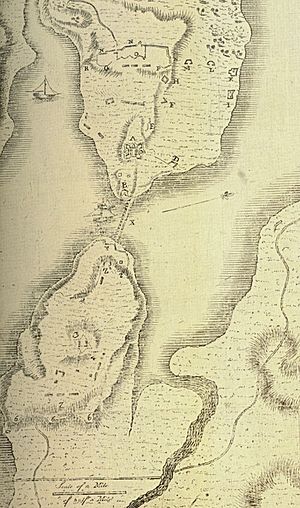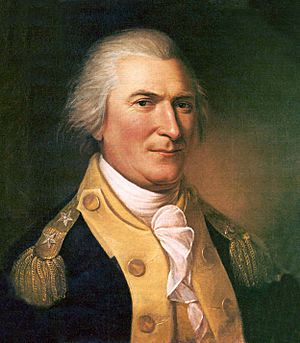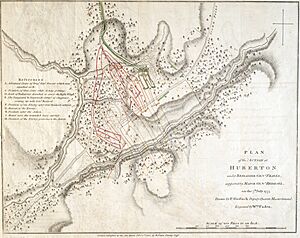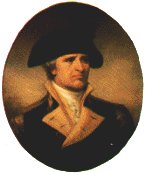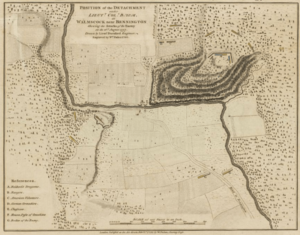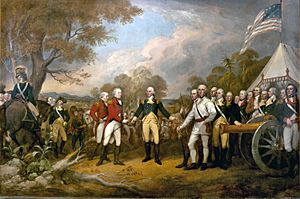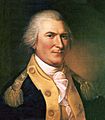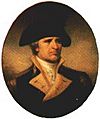Seth Warner facts for kids
Quick facts for kids
Seth Warner
|
|
|---|---|
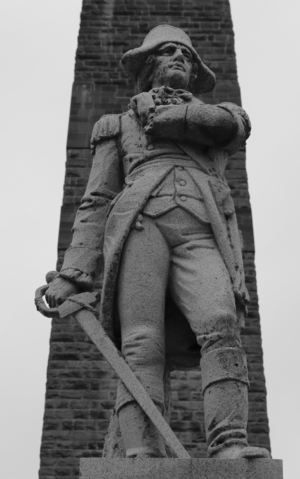
The Seth Warner statue at the Bennington Battle Monument
|
|
| Born | May 17, 1743 Woodbury, Colony of Connecticut |
| Died | December 26, 1784 (aged 41) Roxbury, Connecticut |
| Buried |
Seth Warner Burial Site, Roxbury, Connecticut
|
| Allegiance | |
| Service/ |
|
| Years of service | 1775–1780 |
| Rank | Colonel |
| Unit | Green Mountain Boys (1775–1776) Warner's Additional Regiment (1776–1780) |
| Battles/wars | |
| Relations | Remember Baker (cousin) Olin Levi Warner (great-great-nephew) |
Seth Warner (born May 17, 1743 – died December 26, 1784) was an important American soldier. He was a brave officer from Vermont during the American Revolutionary War. He became a high-ranking colonel in the Continental Army. People remember him for leading troops in key battles. These include the capture of Fort Crown Point and the battles of Longueuil, Hubbardton, and Bennington.
Before the war, Warner was a captain in the Green Mountain Boys. This group protected settlers in the New Hampshire Grants. Even though New York declared him an outlaw, he was never caught. In the last years of the war, Warner stayed loyal to the United States. This was important because Vermont was an independent state at the time.
Contents
- Early Life and Frontier Skills
- Leading the Green Mountain Boys
- Fighting in the American Revolution
- Later Life and Legacy
- Family Life
- Images for kids
Early Life and Frontier Skills
Seth Warner was born in a hilly area of Woodbury, Connecticut. This place is now called Roxbury. He was the fourth of ten children in his family. His father, Dr. Benjamin Warner, was a doctor.
Warner had a basic school education. He also learned some medicine from his father. An old story says he knew a lot about local plants. He often helped people when other doctors were not available.
As a teenager, Warner fought in the French and Indian War for two summers. He was also known as a very good hunter.
Moving to Vermont
In 1763, Warner's father bought land in Bennington. This town was part of the New Hampshire Grants. New York claimed this land too, saying the grants were not legal.
The Warner family likely worked their land for two summers. Then they moved there full-time in 1765. Seth Warner quickly became a leader in the town. He was chosen as a highway surveyor. Later, he became captain of the town's local army, called the militia.
Leading the Green Mountain Boys
During the land dispute with New York, Warner was a captain in the Green Mountain Boys. This group was also known as the Bennington Mob. They were a militia that protected settlers from New York's authority. Warner was second-in-command to Ethan Allen, who was the main leader. However, Warner often made his own decisions.
Defending Settlers
A big conflict happened on July 18, 1771. It was at James Breakenridge's farm in North Bennington. Warner led the Bennington militia. He made the farm strong against a large group from Albany, New York. This group wanted to remove the settler. No shots were fired, and the New York group left.
New York declared Warner an outlaw. This happened after he hit a New York judge with his sword. The judge was trying to arrest Warner's cousin, Remember Baker.
Even with this violence, Warner was known for being fair. He sometimes showed mercy to New York settlers. For example, instead of burning a New Yorker's house, he let him remove the roof. The settler could then replace it after buying a legal title from New Hampshire.
Fighting in the American Revolution
Capturing Forts Ticonderoga and Crown Point
On May 8, 1775, officers chose Warner as third-in-command. This was for a mission to capture Fort Ticonderoga. But Warner and his men stayed behind on Lake Champlain. They were a rear guard. Meanwhile, Ethan Allen and Benedict Arnold surprised the fort's defenders on May 10.
A day later, Warner captured Fort Crown Point, 13 miles north. This fort was mostly in ruins. It only had nine soldiers. But it held 111 cannons. The best cannons were moved to Ticonderoga. Later, Henry Knox moved these guns to Boston for George Washington.
After capturing the forts, Warner went with Allen to St. John. This was a British outpost in Quebec. Arnold had attacked it and taken a British ship. Allen tried to hold the outpost but was forced to leave by British soldiers.
Becoming a Regiment Commander
On June 23, 1775, Allen and Warner asked the Continental Congress to recognize the Green Mountain Boys as a regiment. Congress agreed and told New York to include them. Most leaders thought Allen would lead the regiment.
But on July 26, 1775, New Hampshire Grant leaders met. They chose Warner as lieutenant colonel by a vote of 41 to five. The reasons for this choice are still debated by historians. Some think it was because of Allen's past mistakes. Others wonder if Allen's religious beliefs played a role. Many saw Warner as a more stable leader.
The new regiment was often called Warner's Regiment. It was different from the Green Mountain Boys before the war.
Invading Canada
Along the St. Lawrence River
In late 1775, an American army invaded Canada. It was led by General Richard Montgomery. They attacked Fort St. John on the Richelieu River.
Warner and his regiment fought near Fort St. John. Then they moved to the St. Lawrence River. They watched Montreal and British ships there.
Warner's main base became the Château fort de Longueuil. This was an old "castle" in the village of Longueuil.
On October 30, British Governor Guy Carleton tried to cross the St. Lawrence. He had about 800 men. Warner, with about 350 American soldiers, stopped them. This American victory at the Battle of Longueuil helped lead to Fort St. John's surrender on November 3.
Montreal surrendered on November 13. Warner's troops entered the city. General Montgomery wanted Warner's Regiment to go to Quebec. But the men had no winter clothes. Many wanted to go home. Montgomery allowed them to return to get ready for the next fight.
Siege of Quebec in Winter
Warner and his regiment were home when General Montgomery was killed. This happened during an attack on Quebec on December 31, 1775. Benedict Arnold was also wounded.
General David Wooster asked Warner for help. He told Warner to gather 500 to 700 men. He wanted them to come to Canada to help.
Within days, men from Vermont and Massachusetts marched north. They crossed the frozen Lake Champlain. They went to St. John, then Montreal, and finally to Quebec. This was a long journey of at least 400 miles.
The American army at Quebec was suffering from smallpox. Warner allowed his men to get inoculated. This was a risky procedure that could spread the disease. But it often caused a milder case. General Arnold had forbidden it. However, Warner's son said his regiment "came off without loosing one Man." Other regiments were badly affected.
By early April, many in Warner's regiment were getting better. They made up a large part of the healthy soldiers outside Quebec.
Retreat from Canada
On May 6, 1776, British ships arrived. The American army had to leave Quebec. They began to retreat.
Warner played a key role in this retreat. He stayed at the very back of the army. He helped the sick and injured soldiers. He encouraged those who were struggling. He often stayed only a few miles ahead of the British. They were chasing the Americans. Because of his efforts, Warner brought most of the sick soldiers safely to Ticonderoga.
Forming a New Regiment (1776–1777)
On July 5, 1776, the Continental Congress decided to create a new regiment. Seth Warner was made its colonel. This new group was called Warner's Additional Regiment.
On July 24, Warner attended a meeting in Dorset. Vermont was slowly forming its own government. Warner and almost all delegates promised to defend the United States. They would fight the British until the war ended.
Recruiting for the new regiment was slow. Warner had trouble getting money for his troops. In the fall, American forces prepared for a British invasion. Warner gathered the militia from Vermont. He led them to the forts on Lake Champlain. General Horatio Gates praised Warner's efforts.
In January 1777, Warner's first men were stationed at Mount Independence. In May, Warner led a raid into a Loyalist area in New York. This raid was very hard on Warner. His health began to fail after it.
Burgoyne's Invasion (1777)
American Retreat from Ticonderoga
By June 15, 1777, Warner's regiment had 228 men. An army of 8,000 British soldiers, led by General John Burgoyne, sailed south. Warner's men helped prepare the forts for attack. His regiment defended the "French Lines" north of Fort Ticonderoga.
In late June, General Arthur St. Clair ordered Warner to gather militia. They were to stop Indian raids. Warner wrote to Vermont leaders from Rutland. He asked for more men and supplies. He stressed that losing the forts would be a disaster.
On July 2, Warner's men fought in a small battle. One of his lieutenants was killed. On July 3, Warner led about 800 militia into the forts. They brought cattle and sheep. These new militia made up about one-fifth of the fort's defenders.
On July 5, General St. Clair decided to abandon the forts. Ticonderoga and Mount Independence were evacuated that night. Warner stayed near the back of the army. They marched east into Vermont. British soldiers, led by General Simon Fraser, chased them.
Battle of Hubbardton
On July 6, the main American army passed through Hubbardton. This was a frontier settlement. General St. Clair told Warner to follow with the rear guard. He was to stop about a mile and a half from the main army.
The rear guard reached Hubbardton late in the afternoon. Warner decided to stay there for the night. He said his men were very tired. About 1,100 men were with him. They included his own regiment and others. Warner and most of his group camped on a hill. This is now Monument Hill at the Vermont State Historic Site.
On July 7, Fraser attacked before 7 a.m. He scattered the men in the valley. But he met strong resistance on Monument Hill. The battle went back and forth. Then German troops arrived.
Colonel Ebenezer Francis was killed. Warner ordered a retreat. The Americans lost 41 killed, 96 wounded, and 234 captured. The British and Germans lost 60 killed and 148 wounded. Hubbardton was a British victory. But it also stopped Fraser from chasing the main American army.
Battle of Bennington
After Hubbardton, Warner and his regiment guarded the area north of Manchester. They were ordered to seize cattle and arrest Loyalists.
By early August, General Benjamin Lincoln and General John Stark were in Manchester. They decided to attack Burgoyne's army. Warner was to command Vermont and Massachusetts militia. He also commanded Vermont rangers and his own regiment. The American army in Vermont grew to over 2,000 men.
The expedition gathered in Bennington. On August 13, Stark learned that an enemy force was coming. This force had over 800 men. They were German, Loyalist, Canadian, and Indian soldiers. The two armies had small fights on August 14. It rained on August 15.
Stark was in charge, but Warner helped plan the attack. Warner lived near the battlefield. On August 16, Vermont militia attacked a hilltop fort. Warner led the left wing. They attacked the Loyalist Redoubt on the east side of the Walloomsac River.
The Americans won the battle. The tired militia began to celebrate. Then over 600 German soldiers arrived. Warner took command during this new fight. His own regiment arrived just in time to help win. Stark wrote that Warner's "superior skill in the action was of extraordinary service to me."
The Germans and Loyalists lost 207 dead and 700 captured. American losses were about 30 killed and 50 wounded.
Burgoyne’s Surrender
Warner was very active after the Battle of Bennington. He once said he was "so continually on the alert that for seventeen days and nights he never took off his boots."
Warner's regiment and Vermont rangers raided Ticonderoga and Mount Independence. They captured 293 British soldiers. They also freed 118 American prisoners.
Warner continued to work with Stark. They led New Hampshire and Vermont militia. They crossed the Hudson River. By October 13, they had taken a narrow pass. This pass blocked Burgoyne's escape. As a result, Burgoyne had to surrender.
After the Saratoga Campaign (1778–1780)
After the victory at Saratoga, there were plans for another invasion of Canada. Warner was important in these plans.
On March 20, 1778, Vermont made Warner its only brigadier general. But Vermont and the United States had growing disagreements. This made Warner's position difficult. From 1778 to 1780, Warner's Regiment served along the upper Hudson River. They also served at Fort George. Warner became increasingly sick with a leg problem. He was often absent.
On September 6, 1780, Warner was seriously wounded. This happened in an ambush by Native Americans. Two of his officers were killed.
His regiment at Fort George was destroyed on October 11, 1780. This was in a raid led by Major Christopher Carleton. The British said 27 Americans were killed and 44 captured. Warner's regiment was disbanded at the end of 1780. Warner then retired from military service.
Later Life and Legacy
In the late 1770s and early 1780s, Ethan Allen and his brother Ira led Vermont politics. Warner's influence became less strong.
Starting in 1780, Vermont secretly talked with the British in Canada. These were called the "Haldimand Negotiations." Historians still debate if Vermont leaders truly wanted to rejoin Britain. Or if they were just pretending to avoid war.
In March 1781, Warner confronted Ethan Allen. Allen then publicly admitted to some contact with the British. The secret talks continued, but Warner was against them.
Warner's health was failing. He returned to Woodbury, Connecticut. He died on December 26, 1784, at age 41. He had financial problems. Most of his property was sold to pay his debts.
Remembering Seth Warner
Seth Warner has often been less famous than Ethan Allen. But he has gained some recognition over time.
Vermont gave 2,000 acres of land to his family. This land is in the northeast corner of Vermont. It is still called Warner's Grant or Warner's Gore. It remains empty and undeveloped.
In the 1800s, writers said Vermont had forgotten Warner. He was the hero of a popular book called The Green Mountain Boys. The author later said the hero was based on Seth Warner.
In 1859, a 21-foot tall stone monument was built for Warner. It is on the town green in Roxbury, Connecticut. Warner's remains were reburied under this monument.
In the late 1800s, the Bennington Battle Monument was built. In 1911, a statue of Warner was placed there. The statue's face is imaginary. No real pictures of Warner were made during his life.
The place where Warner's house stood in Bennington has a special marker. The United States Army also has a tugboat named the COL Seth Warner.
Family Life
Seth Warner had nine brothers and sisters. His brother Daniel Warner was killed at the Battle of Bennington. Another brother, John Warner, was a captain during the Revolutionary War.
Seth Warner married Esther Hurd in June 1766. They had four children: Israel, Seth (who died young), Abigail, and another son named Seth.
His great-grandnephew, Olin Levi Warner, became a famous sculptor in the 1800s.
Images for kids



